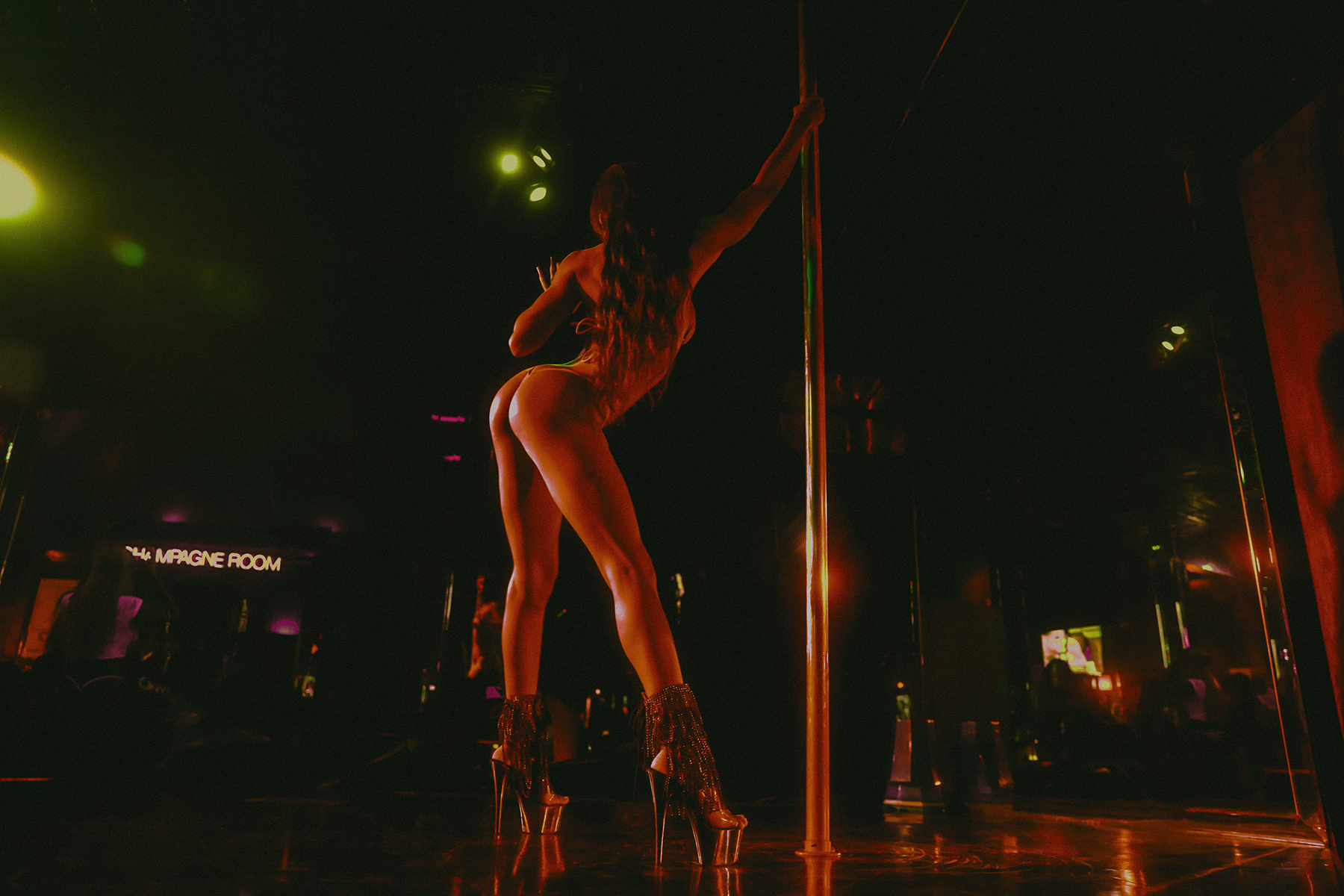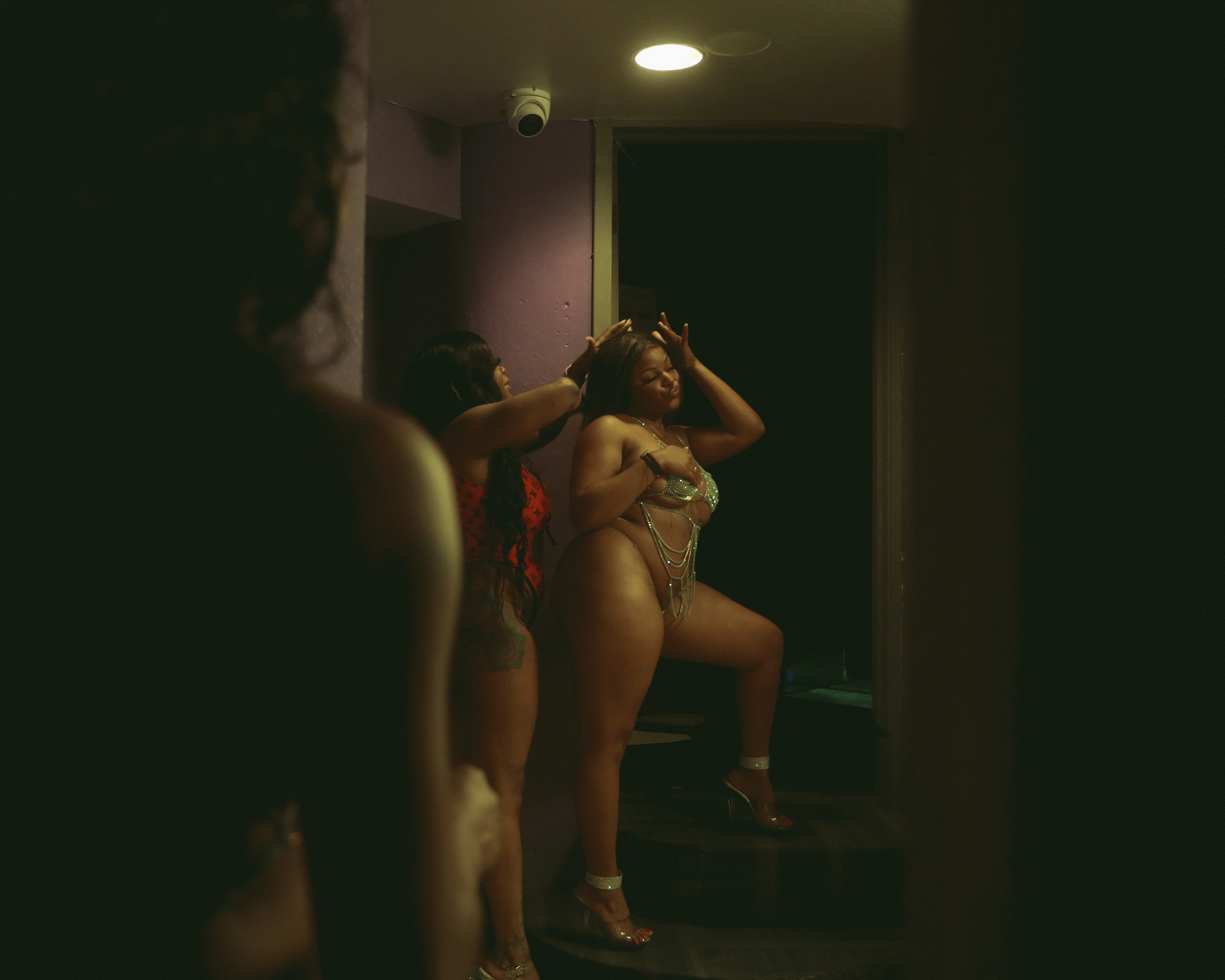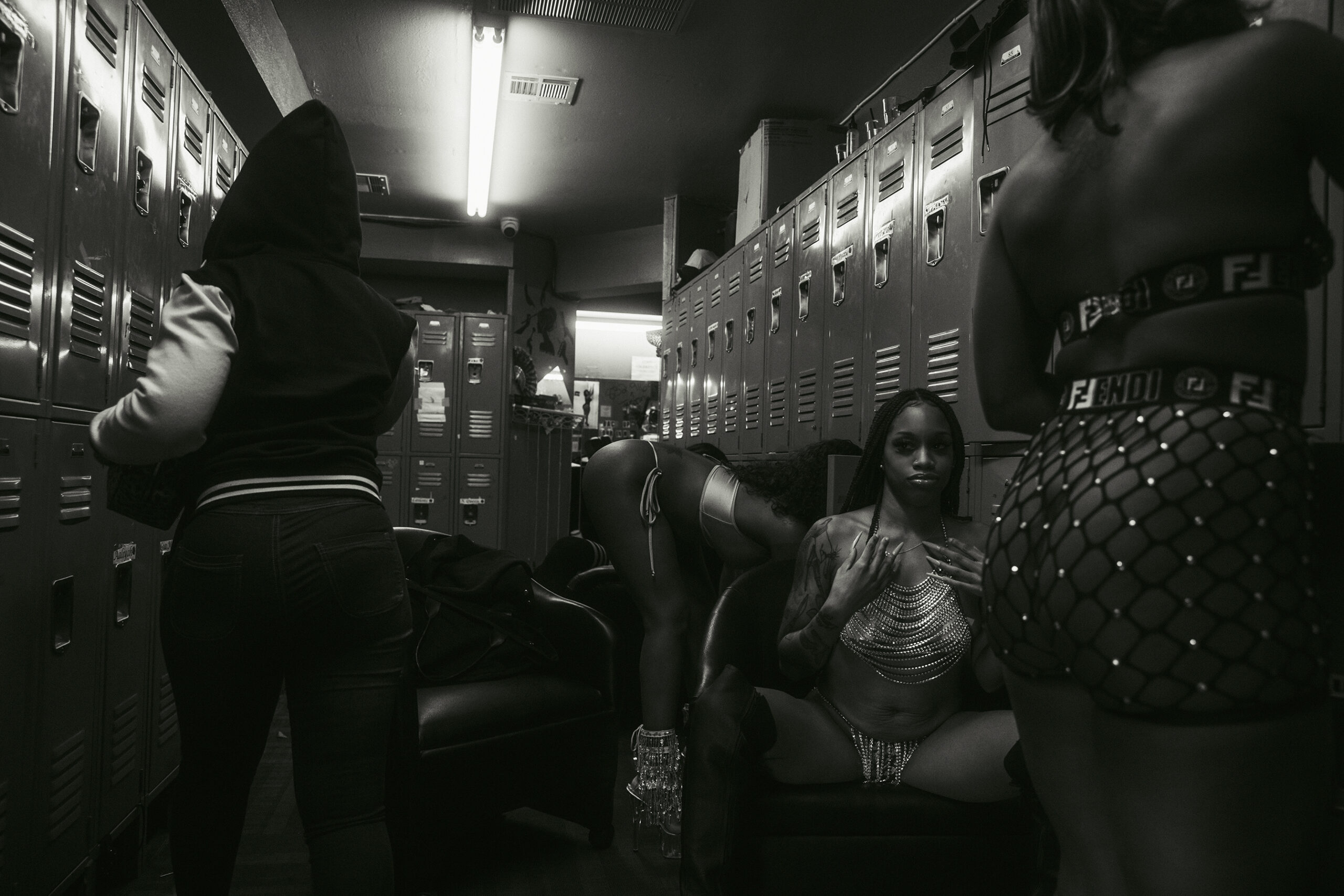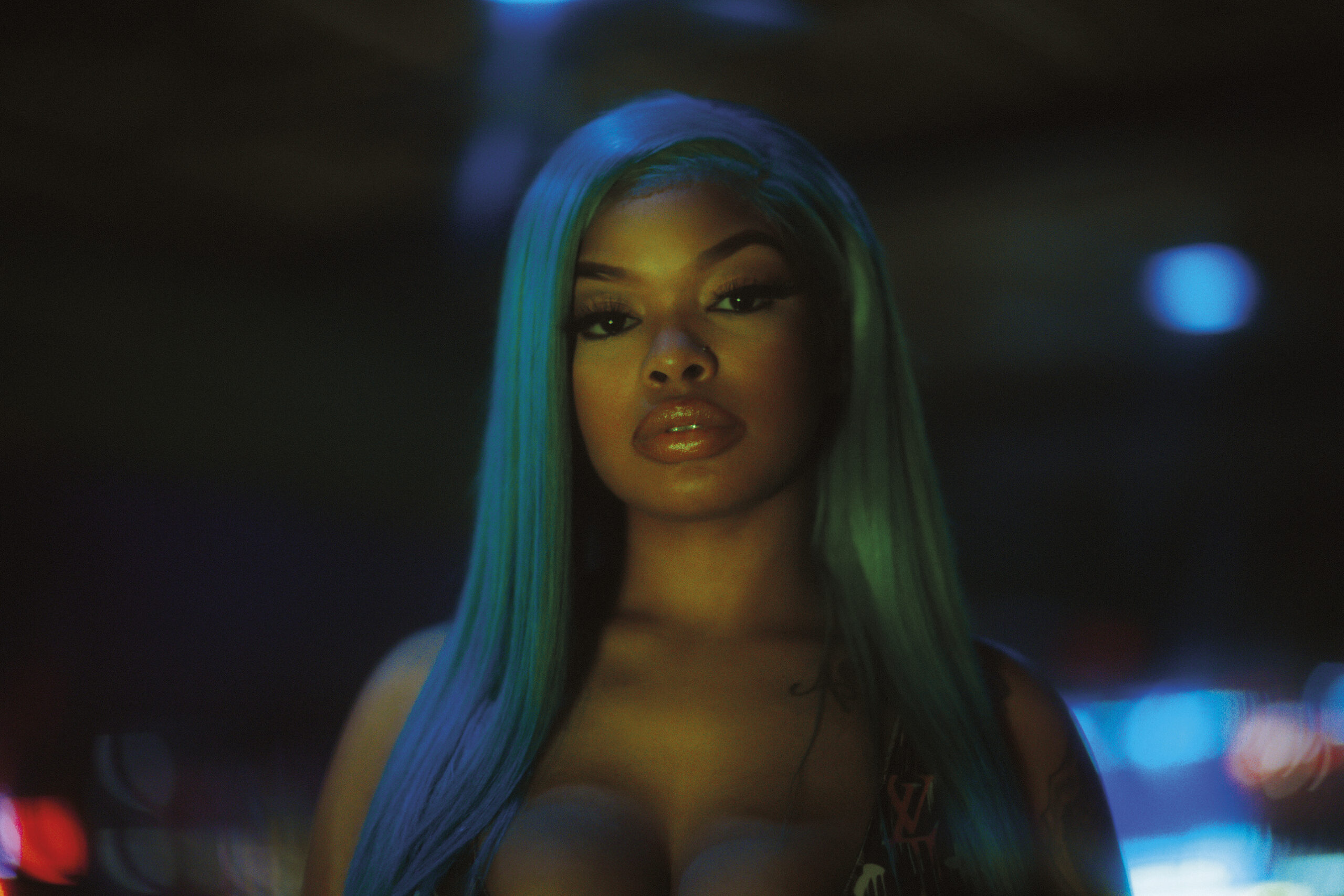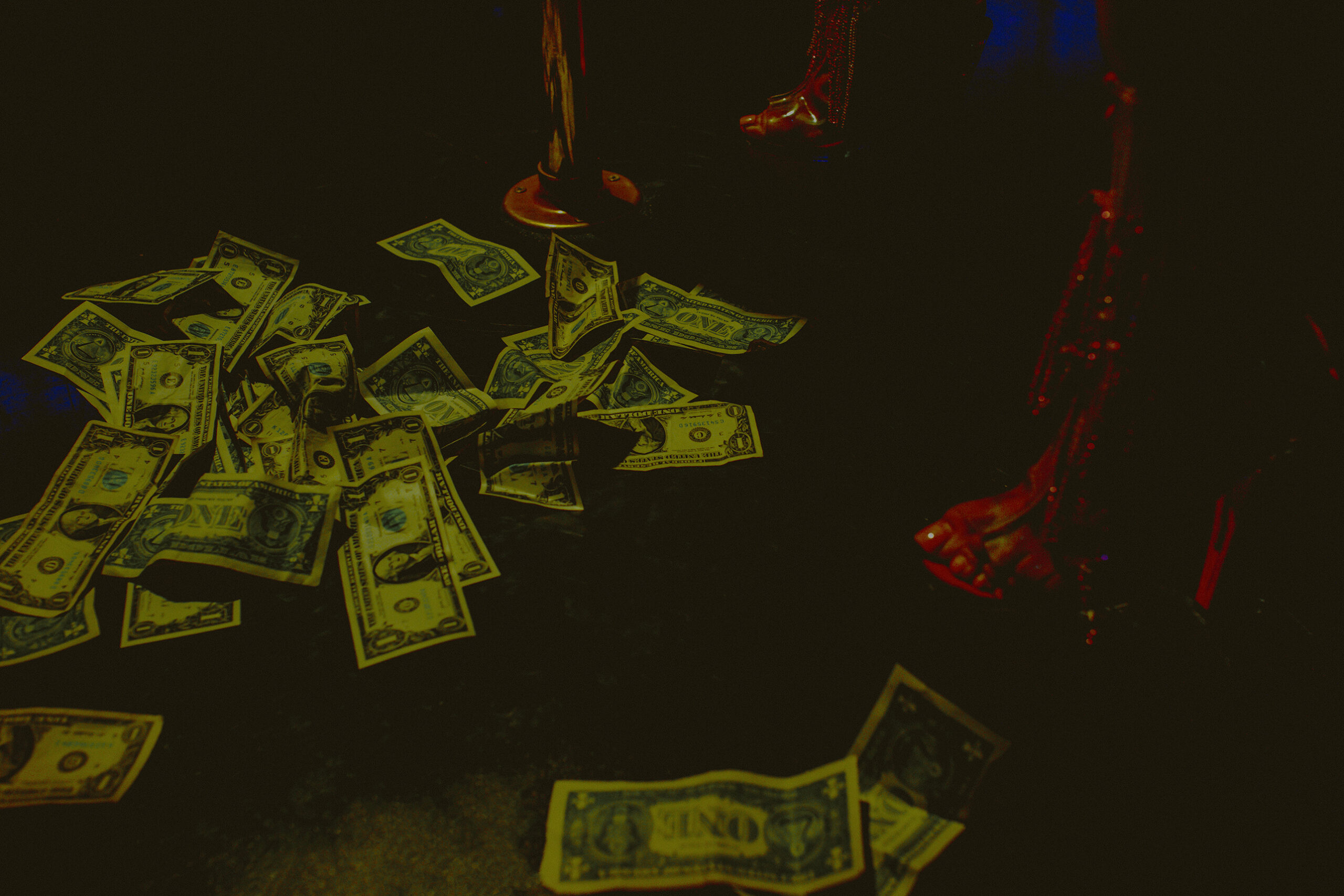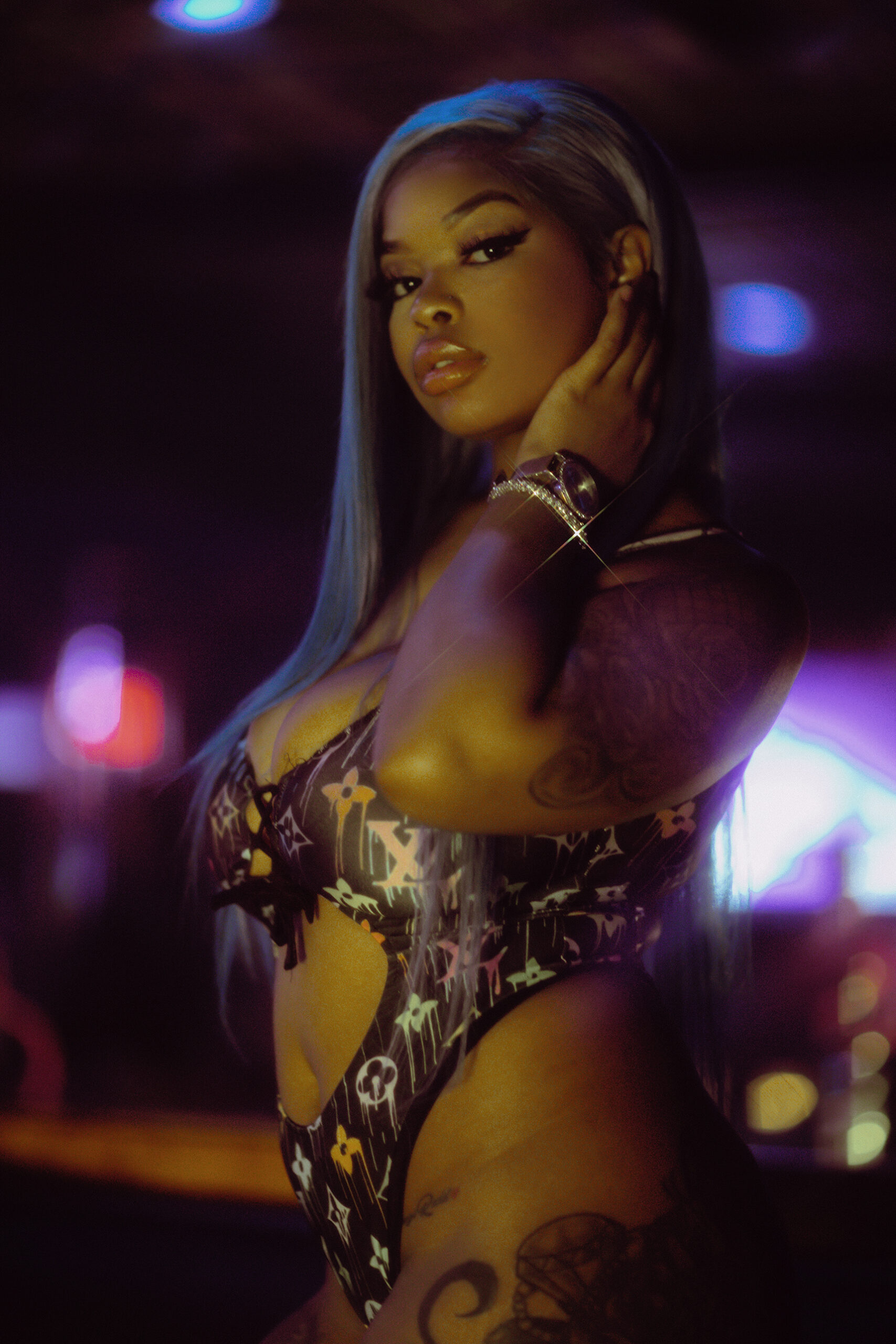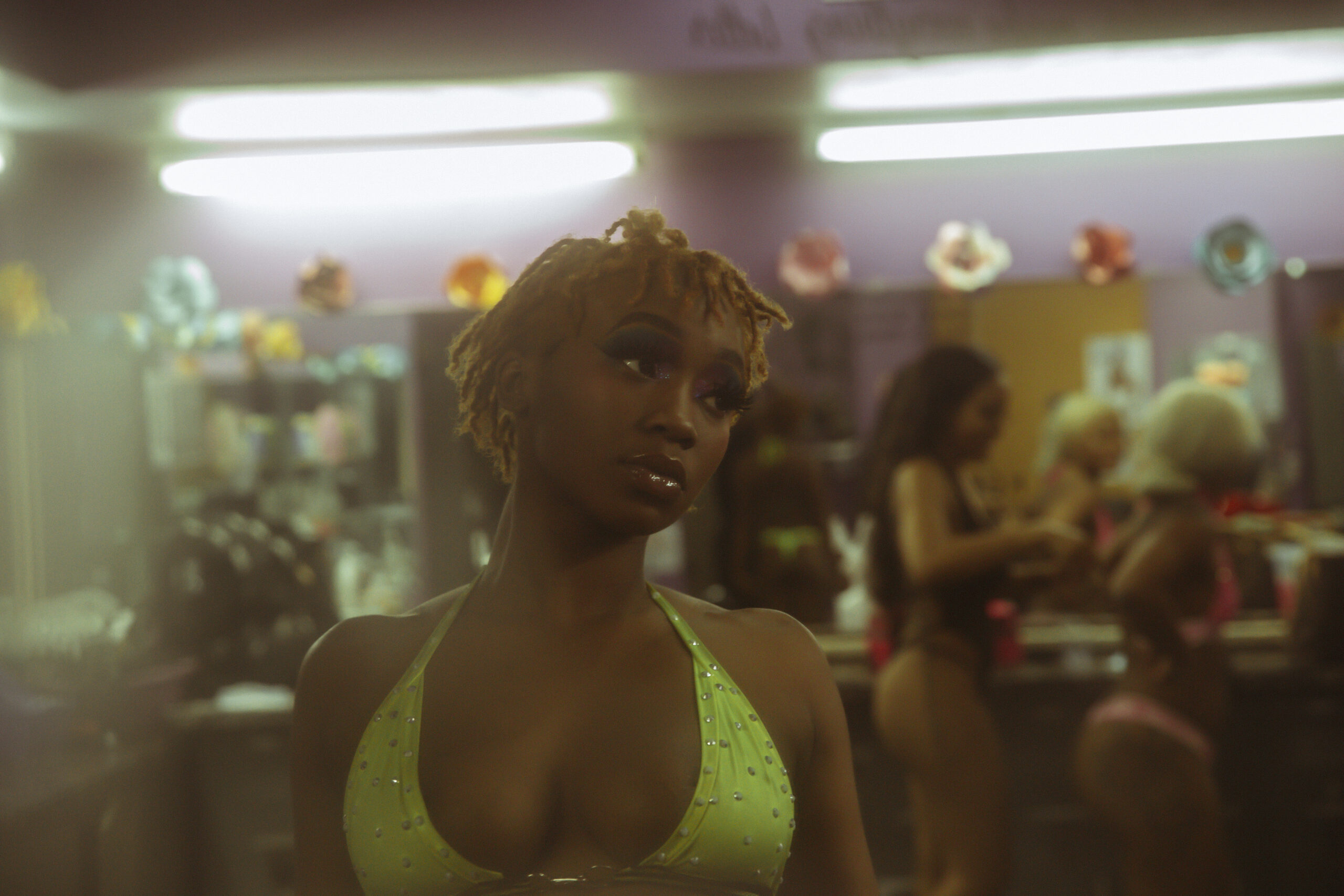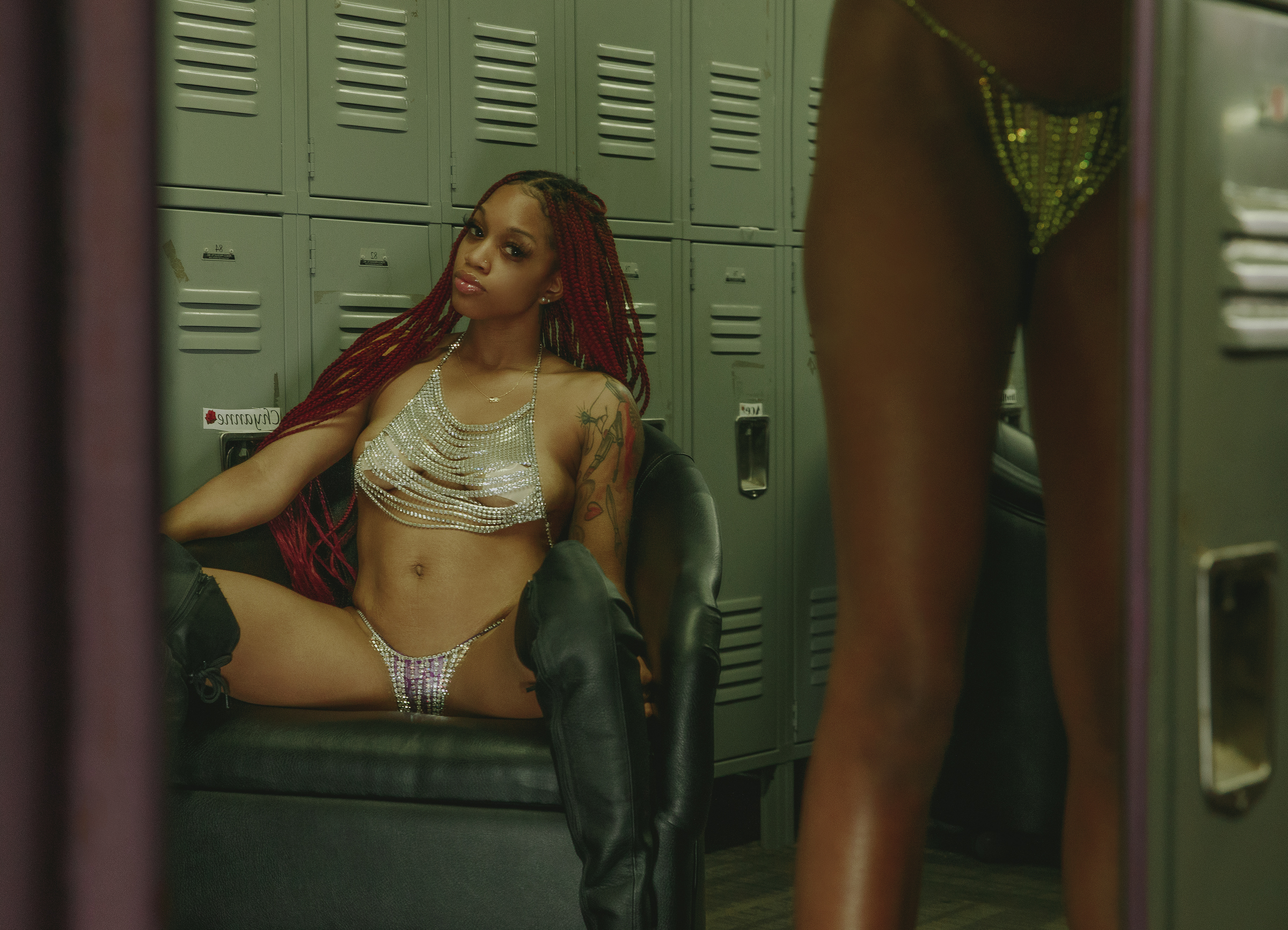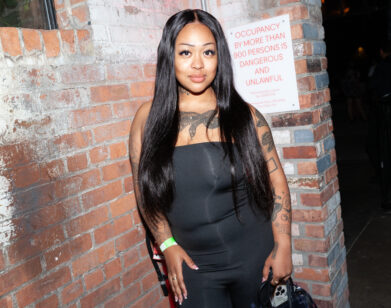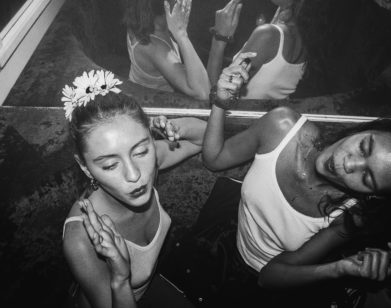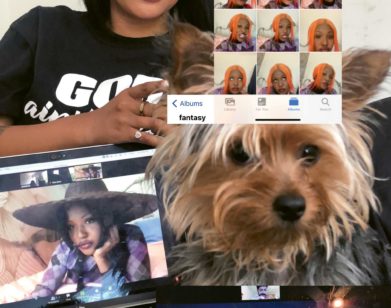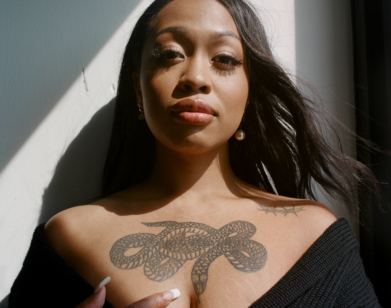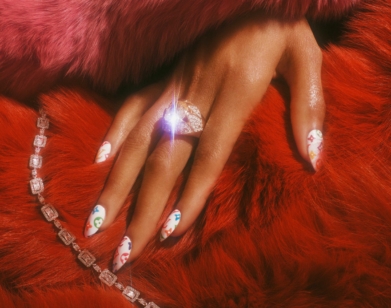CLUB
Adrienne Raquel and Patia Borja Talk Strip Club Culture in the South
Adrienne Raquel’s latest monograph ONYX is by nature a primary source document. You can trace the provenance of any significant work of pop culture in the last 30 years from the Manhattan Soho office to the mood board’s references and, ultimately, much further South of Houston Street. I grew up in Jacksonville and, for me, watching BET Uncut in the early 00s was more than just consuming hip-hop videos on a surface level. It wasn’t merely about tuning in because I wanted to hear songs from my favorite rappers; I was invested in the Black women on TV that exuded confidence and seduction. The video vixen era affected how I viewed what being a Black woman looked like and meant, outside of the history books. Raquel’s photographs of the dancers at the famed Club Onyx in Houston cast them in a similarly reverent light, depicting their sisterhood, strength, and sexuality—and the distinct flavor of Southern strip club culture with journalistic attention.
Photographed over nearly a year in 2020, Raquel’s work takes me back to my mom’s couch, where I sat late at night with admiring eyes watching all the dancers and video vixens on BET Uncut, unable to peel my eyes away. And yet, now more than ever, their impact is undeniable across all mediums. A few days before the book’s publication, Raquel and I got on a Zoom to trade stories about growing up in the South and discuss what makes the region’s strip club culture so singular.
———
PATIA BORJA: The one thing I noticed in this monograph was the influence of the “video vixen” era. And we’re both from the South, in the same age range. I’m 30—
ADRIENNE RAQUEL: I am about to be 33, girl.
BORJA: I didn’t even have cable, but I remember growing up in Jacksonville and the Nelly “Tip Drill” and Ludacris’ “P-Poppin’” music video. My dad was very like, “You are not watching any of that.” But I was like, “Oh my god, these women are so talented and pretty.”
RAQUEL: Absolutely.
BORJA: That’s something I really noticed in the project. I was thinking of the Player’s Club, but what was crazy was that this is the present day. It wasn’t a staged shoot. It was real. When was the first time you went to Club Onyx?
RAQUEL: The first time I went to Club Onyx, I was in college. I’ve always been a very shy, timid girl, even now at my big ass age. And I remember the first time I went I was like, “Whoa.” I felt extremely uncomfortable, but also extremely fascinated by the women that work there and just how they command attention, the way they move. They’re so sexy, they’re confident. The bravado they had, the cockiness. So I’ve always been attracted to that sort of thing. You mentioned the concept of the video vixen, and I grew up in that era where music videos were supreme. My parents were very open. They kind of let me just see and do whatever I wanted. I grew up watching BET Uncut at my cousin’s house when I was spending the night.
BORJA: Yep.
RAQUEL: Vibe Magazine, Source Magazine, XXL, my dad would get a Jet Magazine. I’ve always been so submerged in the culture.
BORJA: What was the process approaching the Club owner like, “Hey, I have this idea”? In New York I’m super confident, but I feel like if I were to go back to Jacksonville, I would definitely be a shy Black girl.
RAQUEL: I was actually very nervous about that. I actually discovered I wanted to shoot it back in 2017. I was with my mom. It was a really funny, very random weekend. My aunt had her 50th birthday here. We did a whole bunch of things and one of the experiences that we had was going to Club Onyx. So that’s when I went there initially and was like, “Oh, I got to come back and document this.” So approaching the club for this project, I was super nervous. So I had to do some research on the actual club. I ended up finding out it’s a corporate thing, it’s under an umbrella. So I had to figure out how to get in contact.
BORJA: Oh, wow.
RAQUEL: And then there’s a friend of mine, who’s like the it-girl here in Houston. And I basically reached out to her. I told her about the project and she was like, “Girl, I got you.” So she was the one that helped facilitate the connection with the club.
BORJA: Did it feel super surreal?
RAQUEL: It was. And when I tell you, I felt so extremely out of place, only because I’m very shy and just timid, but the fascination was there. I felt the allure, although I wasn’t participating. It was just like, “Wow, this is something special.”
BORJA: Did you ever catch yourself forgetting that you had the camera in your hand? How did you keep that composure or when you were in the locker rooms or the floor?
RAQUEL: Honestly, I was a fly on the wall, but my eyes were on the prize and the prize was capturing these amazing moments. So I never forgot that my camera was in my hand. I feel like those weeks that I spent at the club were probably some of the most observant weeks of my entire photography career. And I’ve never been in a situation or in an environment where I just literally have to work with what I have. I’m so accustomed to shooting in studio, or with lighting and all that stuff. So being able to just go and be in that environment was just like, “Whoa.”
BORJA: How many weeks did you spend there?
RAQUEL: I want to say it was about three weeks. I shot it in 2020 when everyone was terrified to go to restaurants and clubs and stuff.
BORJA: Were the clubs still busy?
RAQUEL: Oh, absolutely. I mean, I think they closed down for two weeks, but the club was fully operational. Of course, there were masks and certain protocols in place, but the club was definitely busy.
BORJA: A lot of people don’t really talk about strip club culture. I think people talk about sex workers and strippers, but I’ve never really seen someone encapsulate what you have. I feel like everyone needs to see this monograph. Strip club culture in the south, it’s really its own thing.
RAQUEL: It is.
BORJA: I’ve worked in clubs in New York and I would do sex work on Backpage and in my mind I was like, “Oh my God, I could make so much more if I was in the South and not shy.” With this, I felt like walking through the club and it doesn’t feel orchestrated at all. That’s literally what strip club lighting is.
RAQUEL: Yeah, it’s always giving a mood and a cool vibe. I’m glad to hear that, Patia, because I think that was definitely one of my main goals when shooting this series. We don’t see any men, and you’re really getting this first person point of view perspective of the women and the dancers that work in this club. It almost makes you feel like you’re there or they’re dancing for you. So I’m glad you can see that. That makes me happy.
BORJA: Yeah, and it’s not exploitative.
RAQUEL: Oh, not at all.
BORJA: A lot of photography that touches on these subjects can be very like, damn.
RAQUEL: Yeah.
BORJA: In the girls’ faces, they’re so strong and confident. In my mind, I literally felt like a nine-year-old watching a music video being like, “It’s summer, let me get my brows done or something.”
RAQUEL: I’m glad to hear that, too. I wanted to be really cautious to not be exploitative. With Onyx, the way that it’s photographed and the way the women are truly heroes, you can see how beautiful they are, you can see the artistry in their dancing, you can see their sensuality. I think that is what really makes this series really special. I just really want to pay homage to that and pay homage to the women that work at Onyx and also to Houston. Houston has been such a special place for me, and it’s also where I first discovered and developed my love for photography. And I think it’s only right, like you mentioned earlier, to just have everything connect and come full circle.
BORJA: That’s so amazing. Yeah, I sat and looked at it on the computer and I was just imagining it in a book form like, “Oh my gosh.” In my mind I was like, “Okay, this would be a top five must-have photo.” A lot of people up here don’t listen to Southern rap. I don’t even think people listen to Young Thug that much unless it’s a hit. And I always do that thing where I’m drunk and I start telling people why they should listen to something and then I’ll be like, “They played this at Magic City.” And people are just like, “Girl, what?”
RAQUEL: This is New York. But like you said, strip club culture in the South versus strip club culture in the North, East coast, West coast, it’s just not the same. So I just think there’s naturally a disconnect there, which is also why I really wanted to document this series.
BORJA: A lot of people don’t realize how much is influenced by the South, too. I’m always in debates about this.
RAQUEL: Right. I think a lot of people also don’t realize how much strip clubs really influence culture in general. Whether it’s music, trends, nails, hair.
BORJA: Body.
RAQUEL: Body is a big one, especially in 2020.
BORJA: I remember growing up and it’s like, every Black girl had a big booty. And if you didn’t, you had something to work with, whatever that was. All types of bodies were always included in those clubs. And during a time where society was like, “You’ve got to be skinnier.” And yet those girls were making money. I don’t think people realized the money that these strip clubs make and generate.
RAQUEL: There were definitely nights when I was at Onyx photographing and I felt like money was falling from the ceilings. There’s money covering the floor. I’m being slapped in the face with money. It was such an experience. I’ve been to Magic City and some other places and I feel like Onyx, there’s a certain energy there. It just seems very inviting.
BORJA: It’s also the biggest, right?
RAQUEL: Yeah, and there’s an Onyx also in Atlanta. I’m not sure if it’s part of a chain or not, but I think what makes Onyx special, in comparison to the other clubs I’ve been to, is that it just feels like home. It truly feels like a welcoming environment more or less.
BORJA: On TikTok, the girls that travel in the South to different clubs, they’ll rate which ones are the nicest. Magic City, the girls will be like, “you won’t make money there, it’s so competitive.” It’s interesting to see that as part of strip club culture on the internet, where girls are helping other girls be like, “Okay, this is a club where you can make more friends and work together.”
RAQUEL: That’s another facet of the culture that I really wanted to capture, the dynamic between the women and the girls that work in those spaces and the friendships that they have, the sense of sisterhood.
BORJA: Sisterhood is a big part. And also, maintaining your mental health in these clubs and your sanity. I’m sure everyone feels some sort of stress, or they’re doing it to put bread on the table.
RAQUEL: Yeah.
BORJA: What is your favorite photo and why?
RAQUEL: Ooh, my favorite photo. I have quite a few. There’s an image that I used to kind of headline when I exhibited at Fotografiska in New York back in 2021. There was a dancer, a silhouette of a dancer hanging on the pole. Her name is Callie. And I think that’s one of my favorite photos. I just love her body language. I love the lighting, I love the color, I love the silhouette. I love how you can almost feel like you’re there. And she’s such a skilled dancer, too. To get up there and get on that stage, that requires talent and a lot of confidence. It takes a special type of person.
BORJA: I remember being too shy to even go up by myself to get food at a cookout at a family reunion. I remember once a friend had me go visit her at Rick’s Cabaret Club. And I just remember being like, “Y’all could not go to Atlanta, Miami. You couldn’t do it.” You can’t say this to anyone who doesn’t know what you’re referencing or talking about. It sounds mean, but the standard that black people have is high.
RAQUEL: Oh, it needs to be top tier.
BORJA: It’s giving real fantasy reality.
RAQUEL: It’s funny that you say that, too, because I had a friend that took me to a strip club in LA. And I was just sitting there like, “Oh, it’s a completely different.” There’s a level of flavor and finesse and vibrance and attitude and strength and confidence that I think Black women naturally possess, and women of color naturally possess.
BORJA: This whole interview, everyone’s going to be like, “So why you live in New York?” I love the South. I miss the South.
RAQUEL: Yes. Come back. Come to Houston.
BORJA: I want to. I’ve never been.
RAQUEL: Oh yeah, you’ve got to come to Onyx. Got to come to Houston. Get some food. Go to day parties. See the slabs on Sunday. I’m glad I moved back, too. It’s been almost two years since I moved.
BORJA: I was wondering. I was like, “She lived in New York at one point, right?”
RAQUEL: I did. I was there, New York, New Jersey, for almost nine years. And then I moved back here about two years ago. We actually met, I think, at the vintage shoots.
BORJA: Yes. Before I was getting my BBL.
RAQUEL: You still look good, girl.
BORJA: Thank you so much for doing this with me. I’m awkward.
RAQUEL: No, thank you. This is probably one of my favorite interviews I’ve done because the rest are very like, “So, when did you start photography?” I’m just like…
BORJA: Yeah. “When did you pick up the camera?”
RAQUEL: So this has been good for sure.

